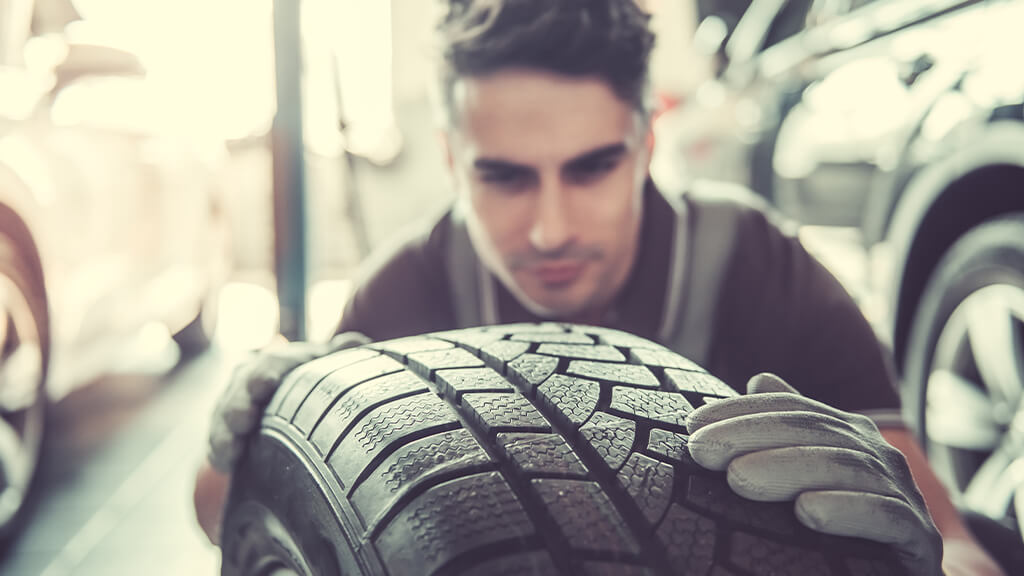Home > Blog > Mobility > What you need to know about changing tyres
What you need to know about changing tyres
Determining the best time to replace old tyres with new ones isn’t always obvious. When are they repairable? At what point do they become less effective? Can they be rotated, or partially replaced? Here are some insights to help you decide.

A good quality tyre can cover l up to 40,000 km of use. However it’s never the amount of kilometres it has done that determines the right time to change your tyres: it’s the level of wear and tear, and in some cases the age of the tyres. However, it is impossible to predict the exact life of a tyre: it depends on the quality of the design, but also on your driving style, the climate, the road conditions, the type of vehicle (tyres wear out more quickly on electric cars), storage conditions when not in use, the damage caused by potholes or speed bumps, etc.
In some cases, tyres may be repaired or rotated, but sometimes there’s nothing left to do: you need a new tyre!
A tyre must be replaced if:
the treadwear indicator has been reached
When the tyre rubber reaches the wear indicator (located in the groove on the tread), that means the legal limit of 1.6 mm depth has been reached. You will need to replace your tyre immediately, as there are certain safety risks involved (grip, braking distance). In addition, you may be subject to a potential fine.
the tyre was manufactured more than 10 years ago
Even if it has never been used or is in perfect condition, a tyre that is more than ten years old is “out of date” because the rubber hardens and becomes brittle. Replace it immediately, and remember that this time limit also applies to the spare wheel!
Don’t know how old the tyre is? Check the DOT (Department of Transportation) marking on the sidewall. The last number indicates the week and year it was manufactured. For example, 1119 = the 11th week of the year 2019.
the shoulder or sidewall is damaged
Unfortunately, punctures in these areas are usually not repairable.
the tread is perforated by more than 6mm
Punctures in the groove are not repairable
when the hole diameter exceeds 6.4 mm.
In principle, a tyre can be repaired:
if there is a minor cut or puncture in the tread that does not exceed 6.4 mm
Note: puncture kits are not enough! They should only be used as a last resort, as a temporary repair until the tyre can be professionally examined.
Signs of ageing: should the tyre be replaced?
It is important to check your tyres regularly for signs of wear and tear, especially after five years, and always before a long journey such as a holiday trip. Look out in particular for pressure losses, deformations or cracks in the tread, as well as lacerations or deformations (bulges) in the sidewall. When in doubt, seek professional advice.
It may be that despite some signs of wear, your tyre can still hold out a little longer. However, this is not always the best idea: even before reaching the legal limit, the wear on your tyre can affect its road grip and braking quality (at 3 mm of depth for summer tyres and 4 mm for winter tyres). In addition, a worn tyre can lead to up to 20% higher fuel consumption! Waiting until the last moment to change your tyres is therefore not an economical choice…
Change one, two or four tyres?
There’s no need to spend extra money on a new pair of tyres if you can just replace one, as long as you meet two conditions:
- it must be the same type of tyre as the one being replaced also the tyre should be the same brand, but most importantly it should have the same dimensions and the same load and speed ratings.
- the difference in wear versus the tyre on the same axle must be less than 5 mm.
If these two conditions are not met, then you will have to change them at least in pairs (either both front or both rear). However, there is no need to change all four if one pair of the same axle is still in good condition.
Uneven wear and tear? Remember to rotate your tyres as soon as possible!
In general, tyres do not wear at the same rate at the front and rear of the vehicle. For this reason, it is recommended to rotate them every 10,000 km for more even wear, though you can rotate them more frequently if you notice irregular wear. Of course, don’t forget to investigate the cause: it could be a misalignment or balancing problem, or a tyre pressure problem (under-inflation or over-inflation).
Thinking of rotating your tyres yourself? The process varies depending on whether you have a front-wheel drive, rear-wheel drive or four-wheel drive vehicle.
However, if your vehicle has different-sized tyres or rims on the front and rear axles, rebalancing will be necessary after each tyre rotation.
Front-wheel drive
- the front tyres are moved to the rear: the right front goes to the rear right, and the front left to the rear left
- the rear tyres are moved diagonally to the front (unless the tyres are unidirectional or asymmetric): the rear left goes to the front right, and the rear right goes to the front left
Rear-wheel drive
This method is the exact opposite of the previous one:
- the rear tyres are moved to the front: the rear right goes to the front right, and the rear left to the front left
- the front tyres are moved diagonally to the rear:the front left goes to the rear right while the front right goes to the rear left
Four-wheel drive
Here, the four tyres are crossed:
- the right front tyre goes to the rear left and vice versa
- the left front tyre goes to the rear right and vice versa.
Note: If your tyres have directional treads, make sure to follow the direction of the arrow on the sidewall of each tyre!
When should I swap winter tyres and summer tyres?
To extend the life of your tyres…
- Always inflate them to the prescribed pressure
- Regularly check the alignment
- Store them in the proper conditions. See our article Storing tyres properly.


